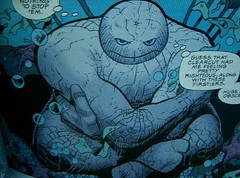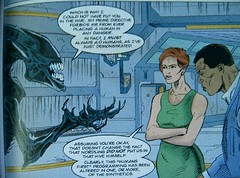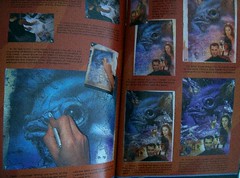The list includes only books and magazines (AV items are excluded).
- Total items read in 2005 = 91 items
- Fiction Vs Non-fiction = 79% Fiction Vs. 21% Non-fiction
- Subject composition (top 3 in terms of %) = Fantasy 23%, Science Fiction 23% (21 items each); Society/ Contemporary Fiction 15% (14 items); Military 4%, Art 4%, Science 4% (4 items each)
- Items from Singapore Collection = 9 (10% of total read)
- Formats = Books 48% (44 books), Magazines 12% (11 magazines), Graphic Novels 40% (36 graphic novels)
- Value of items as per Amazon.com prices (excluding Out of Print items) = USD$1,019.13 (or SGD$1,654.35, as at 28 Feb 2006 conversion rates)
Titles read in 2005:
- 9-11: Artists respond – Vol 1
- 9-11: Emergency relief
- A bit of earth/ Suchen Christine Lim
- A life force/ Will Eisner
- A morbid taste for bones (a Brother Cadfael series)/ Ellis Peters
- AD & D (Asian Defence & Diplomacy)/ Feb 2005 vol 12 no.2
- Aliens: Stronghold/ Dark Horse Comics
- American Gods/ Neil Gaiman
- Analog Science Fiction & Fact/ Jan-Feb 2005
- Asian geographic/ n27, issue 5, 2004
- Asimov's Science Fiction/ Apr-May 2005
- Asimov's Science Fiction/ Feb 2005
- Asimov's Science Fiction/ Jan 2005
- Asimov's Science Fiction/ Mar 2005
- Asimov's Science Fiction/ Dec 2004
- Astronomy/ Aug 2005
- Astronomy/ Oct 2004
- Balzac & the little chinese seamstress/ Dai Sijie
- Cities/ (ed. Peter Crowther)
- City people notebook/ Will Eisner
- Concrete: Killer smile/ Paul Chadwick
- Concrete: Think like a mountain/ Paul Chadwick
- Digital Painting/ (pub. Ballistics/ digital artists master class)
- Dreaming down under/ edited by Jack Dann & Janeen Webb
- Fax from Sarajevo: A story of survival/ Joe Kubert
- Finding Ben: A mother's journey through the maze of Asperger's/ Barbara Lasalle
- Firebirds: Anthology of original fantasy and Science Fiction/ Sharyn November (editor)
- Fistful of colours/ Suchen Christine Lim
- Getting results: Five absolutes for high performers/ Clinton O. Longnecker & Jack L. Simonetti
- Google power: Unleash the full potential of Google/ Chris Sherman
- Heartland/ Daren V. L. Shiau
- Hellboy: Seeds of destruction/ Mike Mignola
- Hellboy: The chained coffin & others/ Mike Mignola
- How to draw and sell comic strips for newspapers and comic books/ Alan McKenzie
- Insider's Singapore: The alternative city guide/ David Brazil
- Iron Council/ China Mieville
- Isn't Singapore somewhere in China, luv? Stories about Singaporeans abroad/ Josephine Chia Over
- King Rat/ China Mieville
- Kite runner/ Khaled Hosseini
- Last day in vietnam: A memory/ Will Eisner
- Lila: An inquiry into morals/ Robert M. Pirsig
- Lonely planet norway
- Marching to Valhalla/ Michael Blake
- New Spring (A Wheel of Time novel)/ Robert Jordan
- Norway rough guide
- Orbiter/ DC Comics
- Perdido Street Station/ China Mieville
- Reading & the reference librarian: The importance to library service of staff reading habits/ Juris Dilevko & Lisa Gottlieb
- Reinventing comics: How imagination and technology are revolutionizing an art form/ Scott McCloud
- Samurai cat goes to hell/ Mark E. Rogers
- Scientific American/ Dec 2003
- Seabiscuit/ Laura Hildebrand
- Seventeen/ Colin Cheong
- Sleeper: Out in the Cold/ Ed Brubaker & Sean Philips
- Space Usagi/ Stan Sakai
- Star Wars: Chewbacca/ Dark Horse Comics
- Star wars: X-wing rogue squadron. Mandatory retirement
- StormWatch Vol. 1. Force of nature/ Warren Ellis
- Stormwatch. Vol. 2. Lightning strikes
- Stormwatch. Vol. 3. Change or die
- Stormwatch. Vol. 4. A finer world
- Stormwatch. Vol. 5. Final orbit
- Stormwatch. Team Achilles. Book 1
- Stormwatch: Team Achilles book 2
- Tangerine/ Colin Cheong
- Terry Pratchett's The light Fantastic
- The alchemist/ Paulo Coelho
- The complete Concrete/ Paul Chadwick
- The dreamer (A graphic novella set during the dawn of comic bks)/ Will Eisner
- The Fantasies of Robert A. Heinlein/ Robert A. Heinlein
- The fifth mountain/ Paulo Coelho
- The five star stories (vol 10)/ Mamoru Nagano
- The green man: Tales from the mythic forest/ Ellen Datlow & Terri Windling (editors)
- The last heros/ W. E. B. Griffin
- The matrix comics Vol 2
- The reef/ Nora Roberts
- The Sandman: Endless nights/ Neil Gaiman
- The Sandman: The wake/ Neil Gaiman
- The Scar/ China Mieville
- The secret history/ Donna Tartt
- The seige of Singapore/ Lim Thean Soo
- The Sgt. Rock archives Vol. 1/ DC Comics
- To kill a mockingbird/ Harper Lee
- Tuesdays with morrie/ Mitch Albom
- Understanding comics: The invisible art/ Scott McCloud
- Void decks and other empty places/ Colin Cheong
- Walk like a dragon: Short stories/ Goh Sin Tub
- We, the media: Grassroots journalism by the people, for the people/ Dan Gillmor
- Wildcats Version 3.0: Brand Building
- Wildcats Volume 3: Serial boxes
- X-wing Rogue Squadron: Mandatory Retirement/ Michael A. Stackpole
Almost-read in 2005
Nil - I guess I was pretty selective this year.










































